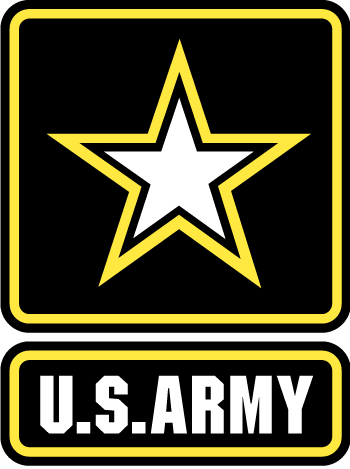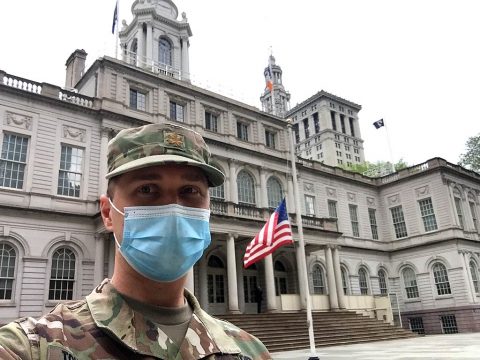 New York – Maj. Olli Toukolehto recognized the wear on the faces of healthcare workers each time he walked into the Javits Convention Center from his hotel in lower Manhattan.
New York – Maj. Olli Toukolehto recognized the wear on the faces of healthcare workers each time he walked into the Javits Convention Center from his hotel in lower Manhattan.
He had witnessed the same strain on the faces of fellow Soldiers while deployed during the Iraqi surge.
Caring for COVID-19 patients in the nation’s coronavirus epicenter has taken a mental and physical toll on New York City doctors, nurses and emergency medical technicians, as the number of coronavirus deaths in the city nears 14,000.

“They’ve seen death for day in and day out,” said Col. Brandon Pretlow, 531st Hospital Center commander from Fort Campbell, Kentucky. “The grueling number of hours and days that they worked … and the number of fatalities that they watch … It’s taken a traumatic effect on them.”
Pretlow led a medical unit tasked with setting up one of two deployable field hospitals at the Javits Convention Center in Hell’s kitchen. Toukolehto, an Army psychiatrist and deputy department chief of adult behavioral health at Fort Belvoir, Virginia, has been deployed to New York City for more than a month, first as a COVID-19 Coronavirus physician, and then as a psychiatrist.
New Role
As hospital workers toiled under increasing pressure to meet the demand for care, the officers’ roles changed. After meeting with New York City Emergency Management Commissioner Deanne Criswell late last month, Toukolehto and Pretlow formulated a plan to help healthcare workers on a more innate level by drawing on their past experiences.
They shared insights and helped in the development of web-based trainings to help healthcare workers and first responders cope with the stresses and pressures of working in pandemic conditions.
To help NYC healthcare workers weather the crisis both at home and in the field, the Army partnered with the Greater New York Hospital Association, the NYC Fire Department and the Defense Department in fielding a collaborative program to help healthcare workers maintain mental health.
They would apply lessons from their military service to the pandemic crisis in the nation’s largest city where more than 43,000 remain hospitalized as of May 4th, despite a recent decline in fatalities. The plan will be to eventually distribute the training to over 150 New York hospitals.
“We’ve been at war for the last 18 years and we’ve learned a lot about traumatic-event management and combat stress control,” said Pretlow, who leads about 800 Army, Air Force and Navy doctors, nurses and medical troops assigned to augment 11 hospitals within the New York City Health and Hospital Network. “So we could potentially share some of those ideas and things using some of our behavioral health professionals and have them kind of work hand-in-hand with the behavioral health professionals of the New York City.”
Providers working at New York’s strained hospitals experience symptoms similar to Army medics and Soldiers at war: anxiety, stress and mental and physical fatigue, Pretlow said.
Toukolehto, a 15-year veteran, deployed to a forward operating base in Iraq from 2006-2007 as a medical lab technician with the 10th Mountain Division. Now each day he makes resiliency training films designed to give hospitals a glimpse of how the military teaches service members skills that they may need when combating the stressors of extended deployments.
He worked in the middle of the conflict’s mass casualties during medical and security operations, often laboring around the clock. Toukolehto remembered the mental distress. He heard news of suicides. As an Army psychiatrist he wants to help shield New York’s healthcare workers from the same fate.
“It doesn’t matter how tough you are,” Toukolehto said. “If your resiliency is slowly being chipped away by the elements or physiological stress … it’s rough. And I think that it’s maybe worse for some of the people here because at least we had a date when we could leave the country.
“But here with COVID (19), a lot of people don’t know how long this is going to keep going,” he said. “So it makes people feel out of control, and can really feel overwhelming when you don’t have an end date.”
A Battle On Two Fronts
The battle healthcare workers fight has a stark difference compared to deployed combat overseas.
The nurses, doctors and EMTs bring the war home every day.
They must carry the stresses with them into an enclosed household with other family members and sometimes that might spark domestic conflict. Workers under stress may turn to substance abuse, which may lead to domestic violence.
“People are obviously trying to cope with the stress, you know, in one way or another,” Toukolehto said. “And then when people are stressed out, their anger is more difficult to control because people are stuck inside … and they don’t have their usual outlets or activities or work.”
Healthcare workers’ duties during this crisis have reached beyond their normal scope. They often act as surrogate family members for their patients, who must remain separated and quarantined from their families. The patients can only connect to family through FaceTime or phone calls, while healthcare workers must comfort some patients in their final moments. Some have also lost colleagues to the virus.
“This is simply not a role that even people who have served in combat have ever had,” said Dr. Joshua Morganstein, assistant director of the Uniformed Services University’s Center for Traumatic Stress in Bethesda, Maryland.
And when a patient passes, they have little time before they are rushed to care for the next patient. “They haven’t really had a chance to breathe and process what they went through,” Pretlow said.
Benedek, professor and chair of the USU psychiatry department, said that the situation in New York presents a unique challenge, where healthcare workers and their family members live and work within enemy territory.
“Their ability to provide for their own self care is significantly challenged and there are constant and ongoing threats to safety,” Morganstein said. “Right now the enemy is on their turf. And the enemy is invisible in New York.”
Healthcare workers also must take on the somber task of telling patients’ family members that their loved ones have passed. The Center for Traumatic Stress developed materials to help overcome the associated stress.
New York healthcare workers will have access to the expertise of DOD psychiatrists and behavioral analysts. Toukolehto connected the hospitals to the researchers at the Uniformed Services University and the CTS. Toukolehto’s mentors Benedek and Morganstein, continue to share their insights with the taskforce.
“Their service goes beyond anything we could have asked for,” said New York City First Lady Chirlane McCray. “Their mental health needs should not be overlooked.
Combating Uncertainty
The task force envisions that the resiliency training curriculum will be helpful in teaching awareness and resiliency-related skills to behavioral health providers in New York hospitals. It takes practice to know how to cope with the stress, isolation, and long work hours during a pandemic, Toukolehto said. Each hospital in turn will tailor the curriculum to each their culture, level of exposure, needs, and location.
“That was a very important priority: to make sure they can have a resource where they can get the evidence-based guidelines of how you build resilience and maintain the fighting force,” Toukolehto said.
Toukolehto and his staff have also provided needs assessment surveys similar to unit needs or battle assessments that Soldiers conduct in the field. The intent of the surveys it to guide hospitals assess the psychological needs of their workers.
Finally, the taskforce will aid the training effort by sharing videos on unit-level combat and operational stress control small group presentations. Military behavioral specialists who are still working in the local New York hospitals will also share field their experiences and advice with their civilian peers. A chaplain will also be available to offer additional support in demonstrating how the military uses a broad range of interventions to build resiliency.
One of the missions of a CTS is to provide expertise in psychological consequences for victims and first responders, in the wake of disasters and pandemics.
Civilian healthcare providers will learn how to manage their mental health, deal with fear and uncertainty, and how to speak to children about death.
The CTS also developed guides on managing family conflict and the unique challenges of isolation.
While DOD recently closed the field hospital at Javits last week, Toukolehto said some unit members will remain behind to provide further support. He credits the Army’s pre-deployment resiliency training with helping many service members prepare for the unknown, should they be tasked to remain for a longer duration. He will continue to work with the Greater New York Hospital associations for the weeks to come.
“We were keeping an eye on our own troops also,” Toukolehto said. “So the (troops’ preparedness) really showed that the resilience training that we get before deployment for a mission is very important.”



